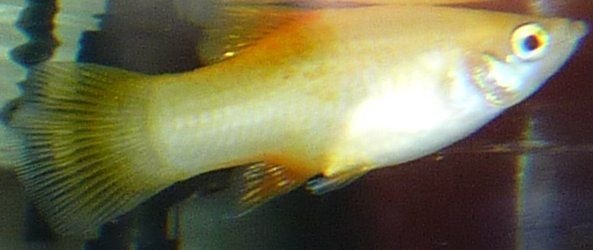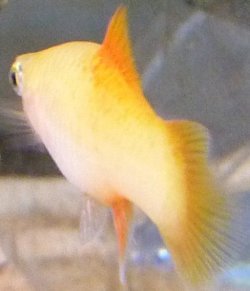One of my 4 adult platies has suddenly gone pale and listless, not eating. I am worried for her, but also for the other three and the 10-11 fry who don't have any symptoms yet. I think the affected platy is probably going to die  , but I hope the others don't catch it too. It could be old age, but i bought the platies just 4 weeks ago. Please help me identify whats causing this and thanks for any help in advance.
, but I hope the others don't catch it too. It could be old age, but i bought the platies just 4 weeks ago. Please help me identify whats causing this and thanks for any help in advance.
Tank size:125liters or 27ish imp.gallons
pH:7.0-8.0
ammonia:0
nitrite:0
tank temp:27-28 degrees C
Fish Symptoms (include full description including lesion, color, location, fish behavior):No external visible symptoms, except she was suddenly very pale in color almost white. She is usually hiding behind the filter, sitting on the bottom of the tank in the sand under the filter or hiding in the rock cave. Swimming sort of tilted to one side. Listless behaviour and not coming out to eat. Just hiding most of the time. This morning when I was feeding she popped up a little but then went back down. She doesn't have clamped fins yet. No other fish have any symptoms yet.
Volume and Frequency of water changes: Weekly 20% changes
Chemical Additives or Media in your tank:Carbon in the filter, a little salt because i was using salt and heat treatment for ich 3 1/2 weeks ago (ich was from the stress of being bought and put in the tank).
Tank inhabitants:4 adult platies (1 male 3 females), 10-11 platy fry and some pest snails.
Recent additions to your tank (living or decoration): Platies-4 weeks ago and some more plants-2 weeks ago
Exposure to chemicals: None that I know of.
Digital Photos:


Thanks again for any help.
Iffles
 , but I hope the others don't catch it too. It could be old age, but i bought the platies just 4 weeks ago. Please help me identify whats causing this and thanks for any help in advance.
, but I hope the others don't catch it too. It could be old age, but i bought the platies just 4 weeks ago. Please help me identify whats causing this and thanks for any help in advance.Tank size:125liters or 27ish imp.gallons
pH:7.0-8.0
ammonia:0
nitrite:0
tank temp:27-28 degrees C
Fish Symptoms (include full description including lesion, color, location, fish behavior):No external visible symptoms, except she was suddenly very pale in color almost white. She is usually hiding behind the filter, sitting on the bottom of the tank in the sand under the filter or hiding in the rock cave. Swimming sort of tilted to one side. Listless behaviour and not coming out to eat. Just hiding most of the time. This morning when I was feeding she popped up a little but then went back down. She doesn't have clamped fins yet. No other fish have any symptoms yet.
Volume and Frequency of water changes: Weekly 20% changes
Chemical Additives or Media in your tank:Carbon in the filter, a little salt because i was using salt and heat treatment for ich 3 1/2 weeks ago (ich was from the stress of being bought and put in the tank).
Tank inhabitants:4 adult platies (1 male 3 females), 10-11 platy fry and some pest snails.
Recent additions to your tank (living or decoration): Platies-4 weeks ago and some more plants-2 weeks ago
Exposure to chemicals: None that I know of.
Digital Photos:


Thanks again for any help.
Iffles


